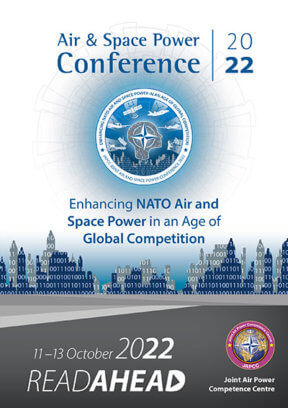The Need for Understanding Deterrence in the Space Domain
At Brussel’s NATO Summit in 2020, NATO Secretary General Jens Stoltenberg launched the #NATO 2030 effort remarking that ‘resilience – be it infrastructure, telecommunications, 5G or healthcare, access to protective equipment – all of that matters for the civilian society, but it actually also matters for NATO as a military alliance and our military capabilities. […] making sure that we have credible deterrence and defence, because that’s the best way to prevent a conflict, is to remove any room for doubt, any room for miscalculation about NATO’s readiness, willingness to protect all Allies. And as long as we provide that deterrence, there will be no conflict, no attack.’1
With that NATO’s Secretary General was basically voicing the general trend, following a number of member states recognizing the importance of space for their economies and as a warfighting domain. Since the United States established a new Command responsible for the Space Domain, other NATO members such as the United Kingdom, France, and Germany acknowledged the importance of space by setting up their respective commands. Consequently, NATO nations and NATO itself decided to bolster their expertise and operational structure by establishing NATO’s Space Centre at Allied Air Command and to set up a dedicated Centre of Excellence for Space.
In recognizing the importance of space, all national efforts are supposed to aim at ensuring the best support to the Alliance’s operations, missions and broader security – as well as the prosperity of their economies. The Alliance as well as its member nations underline the alignment with international law and defensive nature of their policies and actions in space. In parallel, NATO recognises that attacks to, from or within space present a clear challenge to the security of the Alliance and could lead to the invocation of Article 5 of the North Atlantic Treaty anchoring space deeply in the heart of the Alliance.2
In recent decades, space has become a central element for our society. Protection of critical infrastructures in space and on Earth is a priority task for maintaining crucial functions. Likewise, military operations and missions critically depend on NATO Space Functional Areas such as Positioning, Navigation and Timing (PNT), Shared Early Warning (SEW); secure Satellite Communication (SATCOM); Intelligence, Surveillance and Reconnaissance (ISR); Space Situational Awareness (SSA) and Space Weather (Space Wx). Current and future developments across all domains will further accelerate the dependency of the Alliance on Space Support to Operations.3
Consequently, in order to fully recognize the opportunities and challenges of the Space Domain, NATO has to strive for robust and resilient policies, as well as an organisation and a technology base. Besides actively securing reliable services from Space, it has to be made clear to any potential adversary that any attempt to degrade, disrupt or deny NATO’s or member states’ Space capabilities would be unsuccessful and would potentially lead to harmful responses in turn. The military principle of deterrence will work in the Space Domain by creating redundant, robust and standardised structures as well as providing flexible and responsive capabilities.
To create resilience, the existing NATO Integrated Air and Missile Defence could serve as a role model. Interoperability by standardisation of procedures, connectivity for seamless information exchange, integrating national and NATO capabilities and contributions in a robust, meshed network have been cornerstones of NATO’s successful defensive posture in the Air Domain for decades. Even now in the light of the ongoing crisis at NATO’s eastern flank, NATO’s air defence proves to be swift, present, flexible and deterrent.
Besides a robust and redundant standing structure, the capability to quickly reconstitute lost elements, augment existing capabilities, fill unanticipated gaps and enhance survivability in space, i.e. a Responsive Space Capability, is crucial. By generally applying the respective principles and adopting a corresponding mindset, NATO and its members will foster integration and standardization of their space capabilities in a way that finally will uphold their collective deterrence posture in the Space Domain.
The Space Domain in NATO’s Deterrence Posture
Deterrence, either in space or in any other domain, can be understood as an ‘action of discouraging an [adverse] action or event through instilling doubt or fear of the consequences’.4 In space, such harmful interference can be conceived as the loss, disruption, or degradation of space-based services, activities, or capabilities either as a whole or as a function of each of the elements of a space architecture – launch, ground, link, space and mission segment.
Capability, communication and credibility are commonly understood as the key characteristics of sincere deterrence. It requires to have the capabilities to punish and/or deny hostile actions. The consequences need to be communicated to and anticipated by possible opponents. Additionally, measures have to be perceived as credible regarding their extent and the willingness of the actor to suffer counter-retaliation or escalation.5
In its 2020 analysis on the U.S. Space Forces, the Center for Space Policy and Strategy has concluded that, even under optimal circumstances, Deterrence by Punishment will be most demanding, not only due to the technological challenges but particularly due to uncertainties about the adversary’s perception. Deterrence by Denial, i.e. the absorbing of an attack through a robust and resilient Space Domain design at any time and place, might in comparison be the most encouraging approach towards deterrence in the space domain.6 Hence, Deterrence by Punishment will remain the ultima ratio that will most likely be feasible only for a few NATO members.
Deterrence in the Space Domain will need to follow a nuanced policy. Moreover, space policies must not be viewed in isolation and have to be holistically discussed to prevent adversaries from exploiting vulnerabilities. New hybrid space architectures in combination with an overarching Responsive Space mentality will pave the way for a more robust and resilient deterrence posture in the Space Domain.7 More technical speaking, effective deterrence is based on three factors – technological superiority, resilient system architecture, and the operational capability to implement it faster than the adversary.
Responsive Space – A Viable Answer?
Responsive Space ensures unhindered access to information, products and services from space by enabling redundant, interoperable, heterogeneous systems to be networked together. Degraded capabilities can be replaced immediately by re-routing of tasks or rapid replacement of failed systems. Building the technology base, demonstrating innovative and disruptive technologies, and translating them into operational capabilities within NATO is paramount to maintaining superiority and resilience in space.
Resilience is generally understood as robustness and survivability, i.e., the ability of a system to continue to function to an acceptable level or recover quickly after a disruption of any kind and from any source. The resilience of a system can be increased through various techniques, either disaggregation, distribution, diversification, proliferation, or protection. Reconstitution differs slightly because additional satellites must be launched or additional ground stations activated to restore a damaged space-based service.8
To be able to replace lost capabilities or services on demand and on call within weeks, days or even hours, it is necessary to build a Responsive Space capability. In a holistic and integrated approach, the entire operational chain ranging from launch to ground, link and space segment must be able to implement this rapid deployment and entry into service. The capability shall be fail-safe, i.e., redundant and resilient in its operational availability. Mobile, deployable and systems capable of being integrated are of interest, as is the ability for interoperability and combined Command and Control (C2).
In order to exploit the full range of possibilities, connectivity and data exchange between heterogeneous C2 systems will be one of the challenging tasks in the future. Connectivity requires interoperability through compatibility, similarly to the implemented Link 16 standard in the air domain. Modular open system architectures instead of proprietary systems are necessary to allow future C2 concepts. Connectivity with low latencies among the systems will pave the way for future multi-domain operations.9 By additional integration of available commercial services into hybrid space architectures, military and political decision makers are enabled to keep up with rapid changing operational requirements.10
In addition, technological challenges have to be addressed by research and industry following a Responsive Space mentality. Components, systems, architectures and operations need to address that approach.11 Moving away from isolated operations and proprietary systems will be an imperative. Leveraging higher numbers of single sensor or single task systems will likewise require advances in supervised autonomous operations of formations in hybrid architectures. Furthermore, it would require robust access to space enabled by Single Orbit Launch and Early Orbit Phases (LEOP) as well as resilient on-demand launch capabilities.12
To keep pace with the dynamic technological evolution of potential adversaries, it will be essential that NATO member nations participate in the joint development, sustainment, and evolution of state-of-the-art space-based capabilities. General Raymond, U.S. Chief of Space Operations, underlined that ‘the grand challenges cannot be met by individual nations’.13 A joint approach is essential for success. Multilateral efforts such as the Combined Space Operations Initiative (CSpO) strive to align operational processes between multinational partnerships. Importantly, CSpO includes collaboration on enhanced Space Situational Awareness, data sharing and multinational command and control amongst the United States, United Kingdom, Canada, Australia, New Zealand, Germany and France to support space activities.14
Augmenting NATO’s Deterrence Posture in the Space Domain by Responsive Space mentality
NATO as an Alliance does not intent to have its own space-based assets nor any infrastructure in space. Hence, all space-related capabilities, developments or research have to be provided by member nations or have to be procured from commercial providers by NATO agencies.15 As a consequence, all efforts have to aim towards highly integrated and networked space-based capabilities.
In January 2022, NATO published its Overarching Space Policy outlying its basic principles and tenets consistent with its overall posture. Most importantly, it states the further lines of effort on its approach to deterrence, defence, and resilience in the Space Domain. These efforts must be addressed by Responsive Space Capabilities and require further considerations to augment the Alliance’s deterrence posture.16
First, a coherent response to threats will need to consider a range of potential options across the conflict spectrum. Applying the Responsive Space mentality to its maximum extent possible, will allow the Alliance’s deterrence posture in the Space Domain to absorb hostile actions quickly and without actively stressing NATO’s or nations’ decision-making processes.
Second, the Alliance and its member nations will have to develop a common understanding of concepts. Harmonizing their individual approaches to Responsive Space Capabilities will primarily require defining and imposing further standardization.17
Third, readiness is considered a cornerstone within all operational domains. Hence, striving for operational availability across all space related services will be key and is generally augmented by a Responsive Space mentality.
Fourth, by exploiting further international cooperation and collaboration, the Alliance will gain force-multiplying redundancies. The underlying imperative of networking in Responsive Space capabilities will further accelerate this required process.
Furthermore, the Alliance shall strive for guidelines on access to space data, products, services and capabilities. Leveraging NATO’s Science & Technology Organization and multinational efforts such as CSpO to its maximum extent possible, advance on Responsive Space capabilities will holistically foster its deterrence posture.
In summary, fostering a viable Responsive Space mentality and translating it into applicable policies augmenting NATO’s existing Overarching Space Policy will be essential to transfer NATO’s collective deterrence posture to the Space Domain. Responsive Space capabilities will allow all member nations to contribute to the Alliance’s collective defence effort and strengthen the principle of deterrence by denial.














